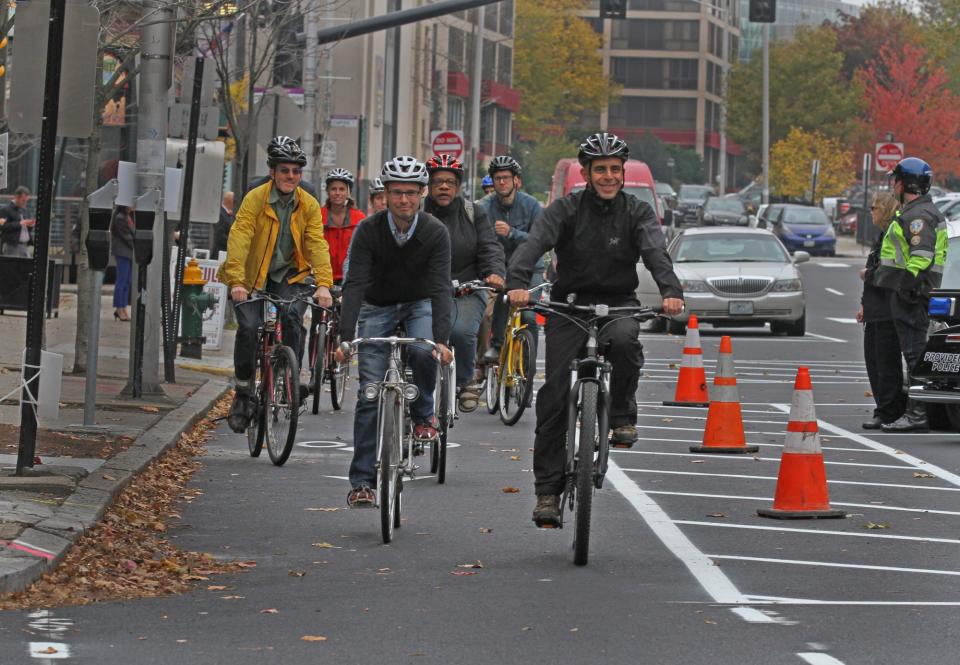Revised DOT carbon reduction strategy has glaring issues | Opinion
Christian Roselund is a writer and policy analyst based in Providence, and serves as Ward 3 coordinator for the Providence Urbanist Network. Daria Phoebe Brashear is a software developer and cyclist from Cranston.
In early October, the Rhode Island Department of Transportation submitted a Carbon Reduction Strategy for public comment that was hard to accept as a serious effort. In our comments, we at Providence Urbanist Network noted that the plan lacked both ambition and any meaningful measures to reduce emissions.
As such, we were pleased to see the DOT publish a revised strategy to address many of the critiques that we and others, including Attorney General Peter Neronha, made. However, the updated plan still falls short of what is needed to tackle emissions in the transportation sector.
The DOT’s revisions address some of the more glaring issues. Centrally, the agency’s move from congestion reduction to mode shift for the majority of Carbon Reduction Program funds was a necessary precondition for this to be a serious plan. Both the DOT’s own numbers and a wealth of research show that congestion management is not an effective carbon reduction tactic.
More: 'We're choking': How an air quality study is mapping which PVD neighborhoods have the worst air
In terms of the more tangible changes, $8.9 million for a pilot program to increase the number of MBTA Commuter Rail trips from Providence to Rhode Island T.F. Green International Airport and Wickford Junction is a welcome addition. The “Rhody Express” could begin to address a major gap in the state’s transportation network by providing a more effective rail link between the state’s only commercial airport and largest city.
Additionally, the inclusion of a line item for sidewalk accessibility improvements for Rhode Island Public Transit Authority bus stops is appropriate — even if $1.5 million is a meager budget for this work.

Unfortunately, many of the other projects that the DOT is proposing for the Carbon Reduction Program are unlikely to be effective in reducing emissions.
The second-largest pot of money ($5.9 million) is dedicated to resurfacing and preserving the Washington Secondary Bike Path. Maintenance of bike infrastructure does not reduce emissions. You need new infrastructure to do that, and maintenance projects should not be claimed under “mode shift.” The Department of Transportation should instead build the new bicycle infrastructure envisioned in the state’s Bicycle Mobility Plan in addition to maintaining the existing network.
Additionally, the two bicycle projects in the Carbon Reduction Program are for a primarily recreational trail, which underscores the DOT’s seeming inability to engage with bicycle infrastructure as a serious means for mode shift. Recreational bike trips don’t get anyone out of a car. A more serious approach to mode shift can be seen in the urban trail network in former Providence Mayor Elorza’s Great Streets program. This includes the South Water Street Urban Trail that the DOT tried to force Providence to remove.
Similarly, a new Providence ferry landing ($1.5 million) might be a nice addition to the waterfront, but it is unlikely to do much in terms of mode shift. This would require more ferry trips or destinations, not a new landing.
As such, while the revised plan is less obviously deficient than the draft submitted for public comment, it still falls short. A serious plan would require seeing buses, bicycles and other non-car means of transportation not as recreation, but as legitimate modes to meet transportation needs.
More: State wants to phase out sales of new gas-powered vehicles in RI by 2035. Here's how they'll do it.
The DOT’s failure has consequences for the state. Transportation is the largest source of Rhode Island greenhouse gas emissions at 38% of all emissions in 2020. DOT leadership’s failure to come up with a serious plan to address this sector puts the state’s target to reduce emissions 45% by 2030 in jeopardy.
The DOT needs leadership that will act on 21st-century needs and priorities. Until then, the agency will continue to drag down the state’s compliance with its legal mandate to act on the climate crisis.
This article originally appeared on The Providence Journal: Many of the projects that the DOT is proposing are unlikely to be effective in reducing emissions.

